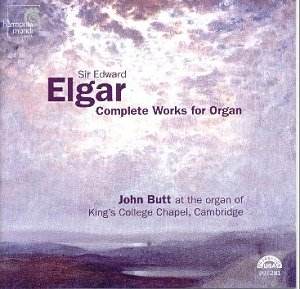The sixty-six minutes or so of music on this album
represents the sum total of Elgarís work in this genre. The works span
the period 1879-1933, practically all of the composerís creative life.
Elgar had firsthand experience of this most majestic of instruments
for he was assistant to his father who was organist of St. Georgeís
Catholic Church in Worcester. Edward himself succeeded to this post
in 1885 and remained there until 1879.
Elgarís G major Sonata was written in 1895 and it is
his most substantial work for the instrument. The opening Allegro
maestoso movement has plenty of colour and drama and John Butt realises
its full nobilmente potential. The succeeding Allegretto
is more lyrical, in a mood of gentle supplication while the long sweeping
phrased Andante espressivo, third movement is cast in that noble
melancholy that Elgar made his own. The Presto, finale, combines
a scherzo-like texture with a march-like second theme and the movement
culminates in a majestic final flourish.
John Butt has also contributed the interesting notes
for this album Ė interesting because he writes from the organistís point
of view. Writing about the G major Sonata he comments, "In all,
the work is one of the most successful Ďorgan symphoniesí of the late
nineteenth century, easily rivalling the vast symphonic works from the
Parisian organ school of Franck, Widor and Vierne.í
The earliest work in the collection is the Cantique
of 1879 (heard here in the composerís arrangement of 1912). Here is
another example of Elgarís noble chivalry mixed with piety and a central
section that pre-echoes ĎThe Spirit of the Lordí which opens The
Apostles. Personally, I think Butt, in his notes, is rather too
disparaging of this little gem. He certainly makes it sound more impressive
than his prose description would have us believe.
Nine short movements comprise Vesper Voluntaries,
published in 1890, and dating from Elgarís first London period when
Lady Elgar and himself, newly weds, were living near the Crystal Palace
in South London. They reflect something of the experimentation that
service accompaniment allowed. All are pleasant, tuneful and they all
follow continental models (Schumann comes to mind at various points)
rather than the traditional Anglican style. The most impressive piece
is the Poco lento, quietly noble, although it sounds a little
too reticent in this rendering: I would have liked to have heard more
attack.
The Loughborough Memorial Chime originated as
a piece for carillon commissioned for a War Memorial opened in 1923.
Elgar retained the right to arrange it for organ. This arrangement survived
only in sketch form but there was sufficient material to make a convincing
piece that combines chimes with a wistful cantilena.
The concert closes with Elgarís Sonata No. 2 in B-flat
major that is Ivor Atkinsí transcription of the composerís Severn
Suite. Butt comments, "...the block-like chords of the opening
Ö [are] so suited to the wind idiom, and the type of attack offered
by a large Cathedral organ. The second movement, Toccata, also clearly
alludes to Bach and the keyboard tradition, although, in Atkinís arrangement,
its rapid figurations seem very reminiscent of the toccata style of
the recent French schoolÖ" The lovely third Fugue/Andante movement
moves forward slowly through quiet prayer-like introspection to an emotional
climax. The eclipsing Coda brings the work to an imposing conclusion.
Buttís grand vision of this colourful work generates considerable excitement.
Butt plays these noble melodic works with flair. For
the most part, Elgarians will be delighted.
Ian Lace


